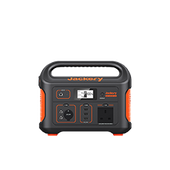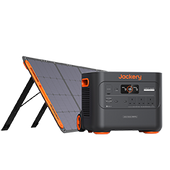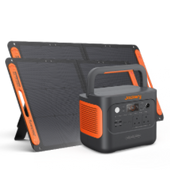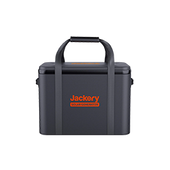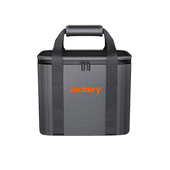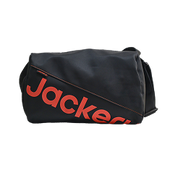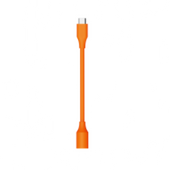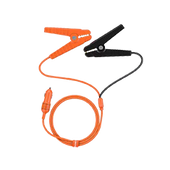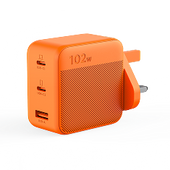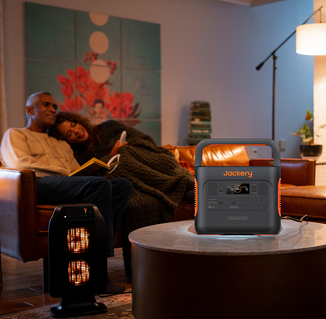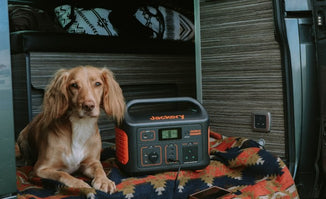Sea fishing in the UK has grown in popularity amongst anglers as it uniquely blends the excitement of challenge with tranquillity. As a popular pastime for many, it offers the thrill of the catch while also serving as a therapeutic escape from life's daily stressors. Sea fishing provides a natural form of relaxation and mindfulness with elements such as the rhythmic sound of waves, the salty sea breeze, and the meditative act of casting a line.
However, modern sea fishing often requires a lot more than just a rod and bait. The process of setting up for a successful experience has changed drastically over time. Many anglers now rely on electronic equipment for navigation, fish finding, and communication due to convenience. However, the reliance on technology introduces a new challenge. Reliable power sources are needed to keep essential gear running throughout the fishing expedition.
Fishing enthusiasts can use Jackery products to power their fishing equipment. Our portable power banks ensure anglers can remain focused on the joy of fishing without worrying about their battery running out. They not only power essential equipment but also enhance the overall sea fishing experience.
Understanding Sea Fishing Basics
Sea fishing, also known as saltwater fishing, is the practice of angling in coastal waters and open seas. In the UK, this popular pastime has a rich history and continues to attract devotees of all ages and skill levels. Various methods are used in the country for sea fishing, and each method is tailored to approach different conditions and wildlife species. Let’s look at the different forms of fishing in the UK before we discuss the techniques and methods employed for sea fishing.
- Shore fishing:One of the most accessible forms of fishing, which involves casting from beaches, rocky outcrops, or piers.
- Boat fishing: It takes fishers further out into the sea, thereby allowing them better access to deeper waters and offshore species.
- Kayak fishing:Kayak fishing has gained popularity in recent years as it allows anglers to explore sea fishing in a much more intimate and environment-friendly manner.
What Fishing Methods Are Used in The UK?
Techniques used in sea fishing include the following.
- Bait fishing:This technique uses natural bait like worms, fish strips, or shellfish to attract fish.
- Lure fishing:It involves the use of artificial lures to mimic prey and attract predatory fish.
- Fly fishing: Itis traditionally associated with freshwater but is also practised in saltwater environments, particularly for species like bass and mullet.
The diversity of fish species in UK waters adds to the thrill of sea fishing. Anglers can target everything from smaller species such as mackerel and whiting to larger, more challenging catches such as bass, cod, and even sharks. The variety in wildlife catch ensures sea fishing remains an engaging and rewarding pursuit for both beginners and expert anglers alike.
Essential Gear For Sea Fishing
Sea fishing requires a carefully curated set of equipment to ensure success and safety on the water.
Rods And Reels: Backbone of The Setup
Sea fishing requires robust and durable saltwater rods and reels. These should have a design that can withstand the corrosive effects of seawater and the strength of ocean-dwelling fish. Rods typically range from 7 to 12 feet in length, with longer rods ideal for casting from shore. Reels should be sturdy, with high line capacity and smooth drag systems.
Bait and Tackle: Luring The Catch
A range of baits and lures is needed for fishing. These can include live bait such as shrimp or mullet and artificial lures such as spoons, jigs, and soft plastics. Tackle boxes should comprise an assortment of hooks, sinkers, swivels, and leader material appropriate for the target wildlife.
Electronic Equipment: Enhancing The Fishing Experience
The use of electronic devices has become increasingly crucial in modern sea fishing. For example, GPS units aid in navigation and help anglers look for fishing spots with a high yield. Fish finders use ultrasound technology to locate fish and underwater structures, which positively impacts catch rates.
Power Solutions: Keeping The Gear Running
To keep electronic equipment operational, many anglers use portable power stations for sea fishing. These devices ensure GPS units, fish finders, and other essential electronics remain charged, even during extended fishing periods. Additionally, safety gear such as VHF radios should always be readily accessible, which also needs power.
Setting Up Your Sea Fishing Gear
When setting up gear for sea fishing UK, anglers start by choosing a rod and reel that suits their fishing style. For general sea fishing, a 9 to 12-foot rod paired with a sturdy spinning reel is versatile. They must also ensure the reel is filled with appropriate line strength, typically 15-30 lb monofilament or 30-50 lb braid, depending on the target fish.
How To Setup A Basic Rig?
Anglers should follow this four-step simple guide to set up a rig to enhance their fishing experience.
- Thread the main line through the rod guides.
- Tie a swivel to the end of the main line using a Palomar knot.
- Attach a fluorocarbon leader (2-3 feet) to the swivel.
- Tie the chosen hook to the end of the leader using a Uni knot.
How To Select and Attach Weights?
Make sure to attach weights using a weight clip or directly to the leader.
- For calm seas: Use 2-4 oz pyramid or ball weights.
- For rough conditions: Choose 5-8 oz grip leads.
Targeting Specific Species, Such as The Sea Bass
Sea bass are a type of predatory fish that respond well to both live bait and lures. Here is how to set it up.
- Live Bait Rig
- Use a sliding ledger rig with a 2/0 to 4/0 hook.
- Thread a whole squid or large sand eel onto the hook.
- Add a small float above the hook to keep the bait off the bottom.
- Lure Fishing
- Attach a 20-30 lb fluorocarbon leader to the main line.
- Tie on a 4–6-inch soft plastic lure or a surface popper.
- Use a jig head weight that is appropriate for water depth and current.
Bait Preparation Tips
There are several things fishing enthusiasts can do to make sure the bait stays fresh.
- Preserve the bait in a cool box.
- Cut larger baits into strips for smaller fish species.
- Use bait elastic to secure soft baits like squid to the hook.
- Consider using artificial baits for convenience and longevity.
Final Tips
- Always check the knots and leader for wear before casting.
- Keep hooks sharp for better hook-ups.
- Adjust the rig based on tide and weather conditions.
- Research preferred baits and habitats of the target species.
- Practice knot tying at home to improve efficiency on the water.
- Carry a variety of hooks, weights, and lures to adapt to changing conditions.
By following these guidelines and adapting the setup to specific conditions and target species, avid anglers can be well-prepared for a successful sea fishing expedition.

Integrating Jackery Power Solutions for Sea Fishing
Sea fishing often requires reliable power sources to keep essential equipment running throughout the trip. Jackery offers multiple portable power stations as well as portable solar power generators that can significantly enhance the fishing experience of anglers. Let’s explore how the Jackery Explorer 300 Plus Portable Power Station, the Jackery Explorer 1000 Pro Portable Power Station, and the Jackery Explorer 1500 Pro Portable Power Station can be integrated into the sea fishing setup.
Jackery Explorer 300 Plus Portable Power Station: Compact Power for Short Trips
The Jackery Explorer 300 Plus Portable Power Station is an ideal companion for short fishing excursions or day trips. Its compact size and lightweight design make it perfect for anglers who prioritise portability.
Key Features
- Capacity: 288Wh
- Output: 300W (600W surge)
- Weight: Approximately 3.75 kg (8.27 lbs)
Benefits for Sea Fishing
- Easily fits in a tackle box or small boat compartment
- Powers small electronic devices like fish finders and GPS units
- Can charge smartphones and tablets multiple times
Practical Applications
- Keep the fish finder running for up to 8 hours
- Charge the smartphone up to 17 times
- Power a small portable fridge for keeping bait fresh
Jackery Explorer 1000 Pro Portable Power Station: Versatile Power For Weekend Trips
For longer fishing expeditions or trips requiring more power, the Jackery Explorer 1000 Pro Portable Power Station offers a significant step up in capacity and output.
Key Features
- Capacity: 1002Wh
- Output: 1000W (2000W surge)
- Weight: Approximately 11.5 kg (25.4 lbs)
Benefits for Sea Fishing
- Powers larger electronic devices and multiple smaller ones simultaneously
- Suitable for overnight or weekend fishing trips
- Fast charging capabilities for quick power-ups between outings
Practical Applications
- Run a marine radio and fish finder simultaneously for extended periods
- Power a laptop for reviewing fishing data or weather forecasts
- Operate a small electric pump for live bait tanks
Jackery Explorer 1500 Pro Portable Power Station: High-Capacity Solution for Extended Trips
For serious anglers planning extended sea fishing expeditions or those needing to power larger equipment, the Jackery Explorer 1500 Pro Portable Power Station provides substantial capacity and output.
Key Features
- Capacity: 1512Wh
- Output: 1800W (3600W surge)
- Weight: Approximately 17 kg (37.5 lbs)
Benefits for Sea Fishing
- Powers high-draw devices like electric coolers and cooking equipment
- Suitable for multi-day fishing trips or live-aboard situations
- Capable of running multiple devices simultaneously for extended periods
Practical Applications
- Operate a large fish finder and chart plotter system for days
- Power an electric cooler to keep the catch fresh during long trips
- Run small appliances like a coffee maker or microwave for onboard comfort
Integrating Jackery Power Stations into The Fishing Setup
Regardless of which model anglers pick, integrating a Jackery power station into the sea fishing setup is straightforward.
- Charge The Power Station: Before the trip begins, fully charge the Jackery unit using AC power at home. For longer expeditions, consider pairing the power station with Jackery SolarSaga panels for on-the-go charging.
- Powering the Gear: Use the appropriate outlets (AC, DC, or USB) to connect the fishing electronics. The Explorer series offers multiple port options to accommodate various devices.
- Managing Power Usage: Use the clear LCD display to monitor power consumption and remaining battery life. This helps anglers to prioritise power usage during the trip.
- Weatherproofing: While Jackery units are not fully waterproof, they are built to withstand outdoor conditions. Still, it is wise to keep them in a protected area of the boat or use a waterproof cover in wet conditions.
- Versatile Placement: The compact design of Jackery power stations allows for flexible placement in the boat. Secure them in a dry area where they won't shift during movement.
How Can Anglers Cook Their Catch with Jackery?
Jackery portable power stations offer a unique opportunity to elevate the sea fishing experience by enabling on-site cooking of fresh catch. With models like the Jackery Explorer 1000 Pro Portable Power Station providing 1000W of power, anglers can easily operate a portable elective stove right on the shore. Here is how to fry sea bass fish using a Jackery-powered setup.
- Clean and fillet the catch.
- Set up a portableelectric stove, connecting it to the Jackery power station.
- Heat a pan with a bit of oil.
- Season the fillets with salt and pepper.
- Cook for 3-4 minutes per side until golden and flaky.
This setup allows anglers to enjoy the ultimate freshness of their catch, transforming their fishing trip into a fulfilling culinary experience. The convenience of having a reliable power source means anglers are not limited to pre-packed meals or basic campfire cooking.
Conclusion
Proper preparation for sea fishing is essential for a successful experience. It involves selecting the right gear, understanding local regulations, and packing a reliable power source. By incorporating a power station into a sea fishing setup, anglers can ensure that their essential electronic gear remains operational throughout the trip. Jackery portable power stations offer an eco-friendly, reliable and versatile solution for anglers, providing clean energy for essential equipment. With these innovative power solutions, fishermen can enhance their experience while minimising environmental impact, making every fishing trip more enjoyable and sustainable.









